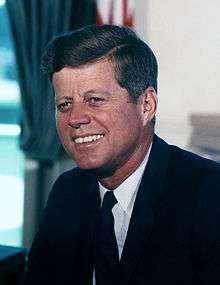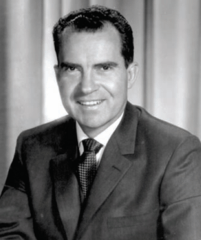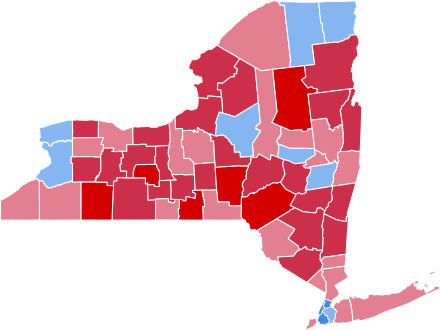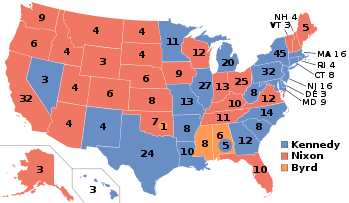United States presidential election in New York, 1960
| | ||||||||||||||||||||||||||||||||
| ||||||||||||||||||||||||||||||||
| ||||||||||||||||||||||||||||||||
|
| ||||||||||||||||||||||||||||||||
| County Results
Kennedy—60-70%
Kennedy—50-60%
Nixon—50-60%
Nixon—60-70%
Nixon—70-80% | ||||||||||||||||||||||||||||||||
The 1960 United States presidential election in New York took place on November 8, 1960. All 50 states were part of the 1960 United States presidential election. New York voters chose forty five electors to the Electoral College, which selected the President and Vice President.
New York was won by Democratic Senator John F. Kennedy of Massachusetts, who was running against incumbent Republican Vice President Richard Nixon. Kennedy was running with Texas Senator, and strongest opponent in the 1960 Democratic Primaries, Lyndon B. Johnson for Vice President, and Nixon ran with internationally popular United States Ambassador to the United Nations Henry Cabot Lodge, Jr..
Kennedy won New York with 52.53% of the vote to Nixon's 47.27%, a victory margin of 5.26%.
New York weighed in for this election as 5% more Democratic than the national average.
The presidential election of 1960 was a very partisan election for New York, with 99.8% of the electorate voting for either the Democratic Party or the Republican Party.[1] In typical form for the time, the highly populated centers of New York City, Buffalo, and Albany, voted primarily Democratic, while the smaller counties in New York turned out for Nixon as the Republican candidate.
Kennedy won the election in New York by a solid 5 point margin, representing a dramatic shift toward the Democratic Party in the state: just four years earlier, Dwight Eisenhower had carried New York State for the Republicans with over 60% of the vote. The results of this election in New York are typical of the nationwide trend of the urbanization of the Democratic Party, and Kennedy's dominance in heavily populated New York City was a vital component to his victory in the state. Kennedy took 62.62% of the overall vote in New York City, to Nixon's 37.04%, and carried four out of five boroughs. Kennedy's victory in Queens, in the midst of a virtual tie nationwide, marked a dramatic turning point for the heavily populated borough's political leanings. Prior to 1960, Queens had been a Republican borough, only voting Democratic in massive nationwide Democratic landslides; it had not previously gone Democratic since the landslide re-election of Franklin Roosevelt in 1936. Beginning in 1960, Queens became a reliably Democratic borough, and since then has gone Republican only once, in the 1972 Republican landslide.
Nixon for his part ran on a platform of continuing the "peace and prosperity" felt throughout the United States under President Eisenhower, which gained him popularity in the developing regions of the Mid-West and Pacific States, while Kennedy attained his popularity in urban regions, in-part, due to his progressive stand on international politics.[2] This included taking a stronger stance with the Soviet Union, which was a very important issue to many city-dwellers, fearing annihilation during the height of the post-nuclear age.
The electors of New York were vital to Kennedy's overall victory, as he defeated Nixon 303-219 in the United States Electoral College. Had Nixon carried New York, then all other things being equal he would have won pluralities both the popular and electoral vote. However, the Republican nominee would have still finished two votes short of an overall majority in the Electoral College, as he would have had a total of 265 of the 267 pledged electors needed to win compared to 258 for Kennedy. The fourteen unpledged electors of Mississippi and Alabama would have held the balance of power in the Electoral College (unable to influence the overall result, these electors opted to cast their votes in favor of Virginia Senator Harry F. Byrd).
Results
| United States presidential election in New York, 1960 | |||||
|---|---|---|---|---|---|
| Party | Candidate | Votes | Percentage | Electoral votes | |
| Democratic | John F. Kennedy | 3,423,909 | 46.96% | ||
| Liberal | John F. Kennedy | 406,176 | 5.57% | ||
| Total | John F. Kennedy | 3,830,085 | 52.53% | 45 | |
| Republican | Richard Nixon | 3,446,419 | 47.27% | 0 | |
| Socialist Workers | Farrell Dobbs | 14,319 | 0.20% | 0 | |
| Write-ins | 256 | <0.01% | 0 | ||
| Totals | 7,291,079 | 100.0% | 45 | ||
Results by county
| County | Kennedy% | Kennedy# | Nixon% | Nixon# | Total |
|---|---|---|---|---|---|
| Albany | |||||
| Allegany | |||||
| Bronx | |||||
| Broome | |||||
| Cattaraugus | |||||
| Cayuga | |||||
| Chautauqua | |||||
| Chemung | |||||
| Chenango | |||||
| Clinton | |||||
| Columbia | |||||
| Cortland | |||||
| Delaware | |||||
| Dutchess | |||||
| Erie | |||||
| Essex | |||||
| Franklin | |||||
| Fulton | |||||
| Genesee | |||||
| Greene | |||||
| Hamilton | |||||
| Herkimer | |||||
| Jefferson | |||||
| Kings (Brooklyn) | |||||
| Lewis | |||||
| Livingston | |||||
| Madison | |||||
| Monroe | |||||
| Montgomery | |||||
| Nassau | |||||
| New York (Manhattan) | |||||
| Niagara | |||||
| Otsego | |||||
| Richmond (Staten Island) | |||||
| Saratoga | |||||
| Schoharie | |||||
| Schuyler | |||||
| Steuben | |||||
| Tioga | |||||
| Warren | |||||
| Washington | |||||
| Wayne | |||||
| Westchester | |||||
| Wyoming | |||||
| Yates | |||||
| Totals | 52.53% | 3,830,085 | 47.27% | 3,446,419 | 7,276,504 |
See also
- African American Civil Rights
- Conservative Coalition
- Cuban Missile Crisis
- Presidency of John F. Kennedy
- The Cold War
References
- ↑ "Dave Leip's Atlas of U.S. Presidential Elections". Uselectionatlas.org. Retrieved 2013-07-13.
- ↑ "THE KENNEDY-NIXON PRESIDENTIAL DEBATES, 1960 – The Museum of Broadcast Communications". The Museum of Broadcast Communications (MBC). Retrieved 2013-07-13.




